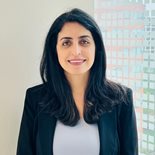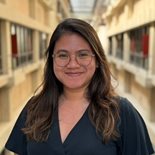Key objectives
- To investigate the fundamental interactions between retina, supramolecules and endothelial cells in vitro
- To generate and evaluate in vitro functional complex retinal cellular constructs using 3D cellular bioprinting
- To generate and evaluate in vitro the next generation retinal organoids including blood vessels, supramolecules and appropriate neural configuration
- To transplant retinal constructs and/or next generation retinal organoids in animal host retinas
Our concept Cell-based therapy
In this pillar, we will develop and combine innovative therapeutic strategies to treat age-related macular degeneration (AMD) and inherited retinal diseases (IRD).
learn moreOur concept Cell-based therapy
Therapies aiming to preserve cells are not an option anymore once a significant proportion of retinal cells have died. Replacing dead cells along with their cell-specific microenvironment (extra-cellular matrix, ECM) is then a last resort. This exciting but challenging endeavour is the core of Pillar 3. Our first goal is to gain fundamental new insights into the properties of, and interaction between, retinal, vascular cells and supramolecules in vitro, to discover the most optimal regenerative visual functionalities. Subsequently, the most promising cells and supramolecules will be used as tools to generate and evaluate in vitro complex retinal cellular constructs using 3D cellular bioprinting, and next-generation retinal organoids-in-a-dish. Finally, we will transplant selected cells, cellular constructs, or whole retinal organoids with their ECM supramolecular matrix into the subretinal space of rat host models, and evaluate the potential of restoration of visual function.
Our approach
The research proposed for Pillar 3 will be performed in 4 work packages.
Work Package 3.1: Interactions between retinal/choroidal cells and ECM
Work Package 3.2: Design and testing advanced cell/ECM constructs
Work Package 3.3: Biosynthetic retinal organoids – in vitro
Work Package 3.4: Transplantation – in vivo
Our innovation
We will implement regenerative medicine approaches for retinal diseases, combining cutting-edge technologies and multidisciplinary expertise to restore vision.
learn moreOur innovation
Regenerative medicine approaches for retinal diseases are still in their infancy, but will be revolutionary for blind patients who are currently without options. To achieve the highly sought-after goal of visual restoration requires input from the entire visual field from bench to bedside. In the vein of Lifelong Vision, this pillar uniquely brings together diverse disciplines in a single team. We will be pioneering combinations of cutting-edge technology, such as stem-cell derived cells and models, supramolecular construction and application, 3D cellular bioprinting of retinal constructs, organoid modelling, progressive eye surgery, and front-line measurements of vision in animals. Each step in Pillar 3 is an innovation in its own right, together the achievements will be truly disruptive.
WP leader
Stephan Huveneers
About me
I lead the Vascular Microenvironment and Integrity lab. My research focuses on the molecular mechanisms of endothelial cell adhesions and mechanotransduction in vascular biology.
Contribution to Lifelong VISION
The Huveneers lab studies angiogenesis using advanced fluorescence microscopy applied in 2D and 3D cultures and in in vivo models. His expertise in cell-cell and cell-ECM interactions in vascularized tissue will benefit the cellular research within Pillar 3 of Lifelong Vision.
Theo Smit
About me
My research focus is on the role of mechanics in biology, in particular embryonic development, growth, disease and repair.
Contribution to Lifelong VISION
In Pillar 3, a cellular therapy for age-related macula degeneration is developed. To support the differentiation of iPS cells into retinal epithelial cells, an electrospun scaffold of supramolecular polymers is required. Furthermore, translation of the basic technology into an advanced therapeutic medicinal product (ATMP) is required.
Team
Céline Koster
About me
I completed my PhD in the section of Ophthalmogenetics at the Amsterdam University Medical Centers in 2022. During my PhD project, I worked on the development of differentiation protocols from stem cells towards retinal pigment epithelium cells, the development of new animal models for retinal degenerative diseases and phenotyping strategies of these preclinical models. Currently, I work as a postdoctoral researcher at the Amsterdam UMC and test experimental therapies for retinal degenerative diseases, including stem cell-derived tissue transplantation and gene therapy approaches in preclinical models.
Contribution to Lifelong VISION
My expertise is crucial in testing experimental therapies in representative and robust preclinical models in Platform A.
Mehran Khajehmohammadi
About me
I'm a PhD candidate at Amsterdam UMC, having joined in 2025, with a focus on 3D bioprinting and retinal tissue engineering. My research aims to contribute to the development of advanced therapies for retinal diseases.
Your contribution to Lifelong VISION
Mehran aims to contribute a strong engineering and computational perspective to retinal research. He seeks to integrate modeling, mechanical characterization, and 3D bioprinting strategies to better understand and replicate retinal tissue. His expertise allows him to approach biological problems with quantitative and design-driven methods. In this way, he hopes to complement the team’s biomedical focus with innovative engineering solutions.
Mitra Farnoodian Tedrick
About me
My professional goal is to better understand the molecular basis of inherited eye diseases and to identify new treatments, especially in areas where no treatment currently exists. For over 14 years, I have dedicated my research to studying retinal pigment epithelium (RPE) cell biology using induced pluripotent stem cell (iPSC)-derived RPE from both healthy and diseased individuals. My current work focuses on developing cell- and drug-based therapies for retinal degenerative diseases, including age-related macular degeneration (AMD) and Stargardt disease. My research investigates the cellular and molecular mechanisms driving inherited retinal disorders with the goal of developing targeted interventions to preserve vision.
Your contribution to Lifelong VISION
My lab is committed to pioneering therapies for retinal degenerative diseases through cutting-edge translational research. By exploring cellular metabolism regulations and dysfunction in ocular tissues, the lab seeks to identify novel pharmacological and stem cell-based therapies to prevent RPE cell death, with a clear path to clinical application. Through collaborative interdisciplinary efforts, my lab drives innovative solutions for the Lifelong Vision Program, harnessing deep disease insights to deliver impact, clinically relevant therapies.

Patricia Dankers
Professor in Biomedical Materials & Chemistry - Eindhoven University of Technology
read morePatricia Dankers
About me
Patricia Dankers is a professor in Biomedical Materials & Chemistry. Dankers leads a research group that aims at pursuing grand challenges in biomedical science, and in particular in the field of regenerative medicine, using a materials approach. Targeting the cell-material interface using supramolecular chemistry is one of the main research directions.
Your contribution to Lifelong VISION
Our group contributes to Pillar 3 through development of different functional materials to steer retinal cells.
Sekar Galuh
About me
I did my PhD on central serous chorioretinopathy and corticosteroids. Now my focus in LLV is on cell-based therapies.
Your contribution to Lifelong VISION
Together with Dr. Stephan Huveneers, our focus falls under the pillar 3, in which we will first investigate the fundamental interaction between retinal, endothelial cells, and supramolecules that recapitulates retinal extracellular matrix. iPSC-derived cells will also be used in our work. We collaborate with other experts, such as Patricia Dankers (TU Eindhoven) and Theo Smit, for generating the new supramolecular materials and new supramolecular hydrogels. Ultimately, our work moves towards the transplantable retinal organoids that will be transplanted in animal host retinas.
Valeria Verde
About me
I am a PhD candidate in the Dankers group at Eindhoven University of Technology, where I focus on tissue engineering by developing supramolecular biomaterials for regenerative medicine. I hold a Bachelor's degree in Biomedical Engineering from the University of Palermo and a Master's degree in Bionanotechnology from the Polytechnic University of Turin, which together have provided me with a strong foundation in biomedical research and materials science. My interest in tissue engineering began during my master’s internship at TU/e, where I worked on developing a 3D bioprinted scaffold for bone tissue regeneration. This experience has deepened my curiosity about how biomaterials can influence cellular behavior and create supportive environments for tissue formation. Now, as a PhD student, I am excited to explore the field of retinal-related diseases and contribute to advancing research that may one day improve regenerative therapies and patient outcomes.
Your contribution to Lifelong VISION
As part of Pillar 3, I am working under the supervision of Prof. Patricia Dankers on the development of supramolecular biomaterial constructs for cell-based therapeutic applications. My research focuses on engineering complex, multilayered retinal tissue constructs using supramolecular biomaterials, with the goal of advancing regenerative strategies in ophthalmology.







